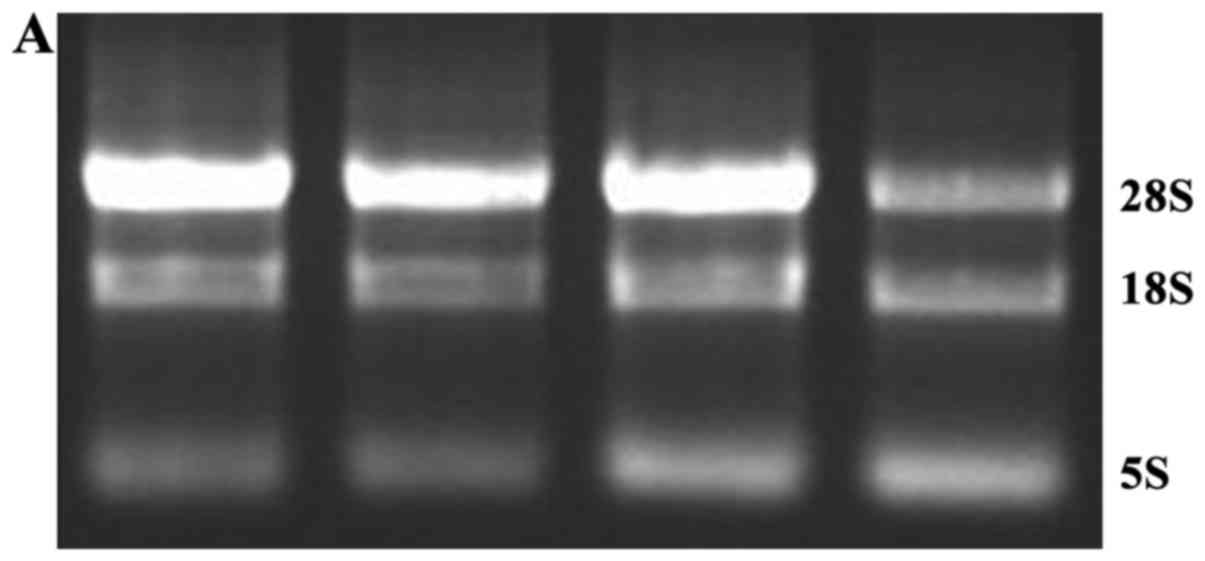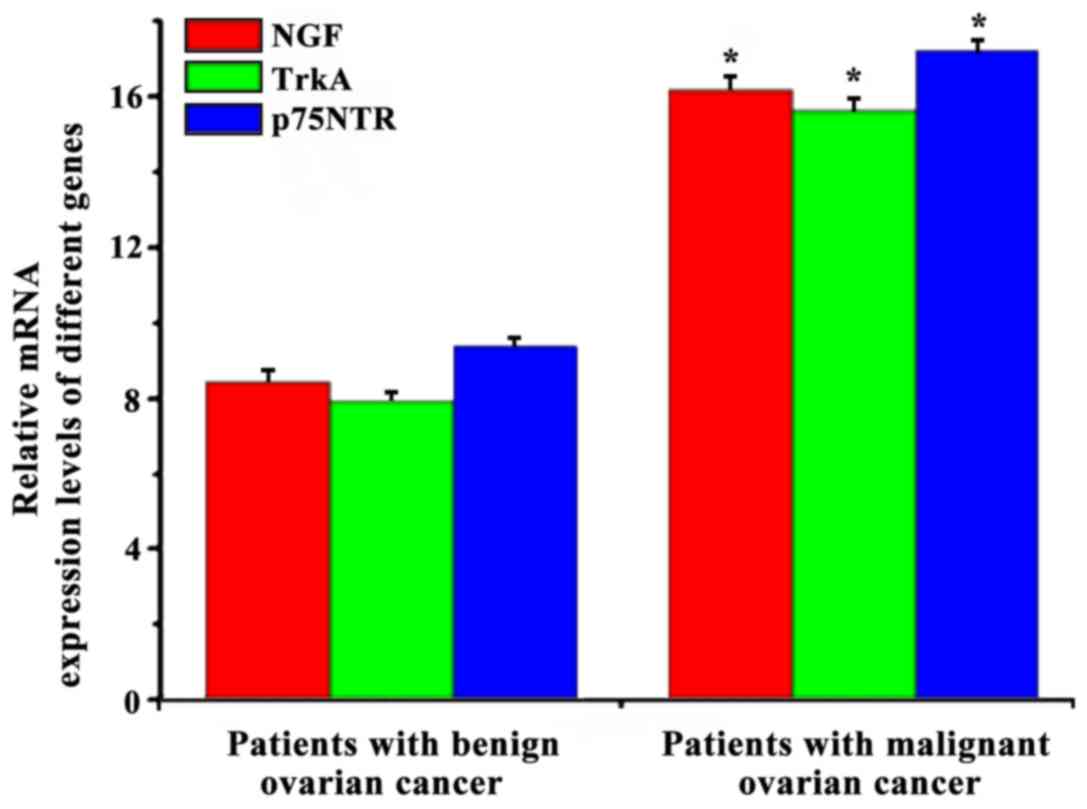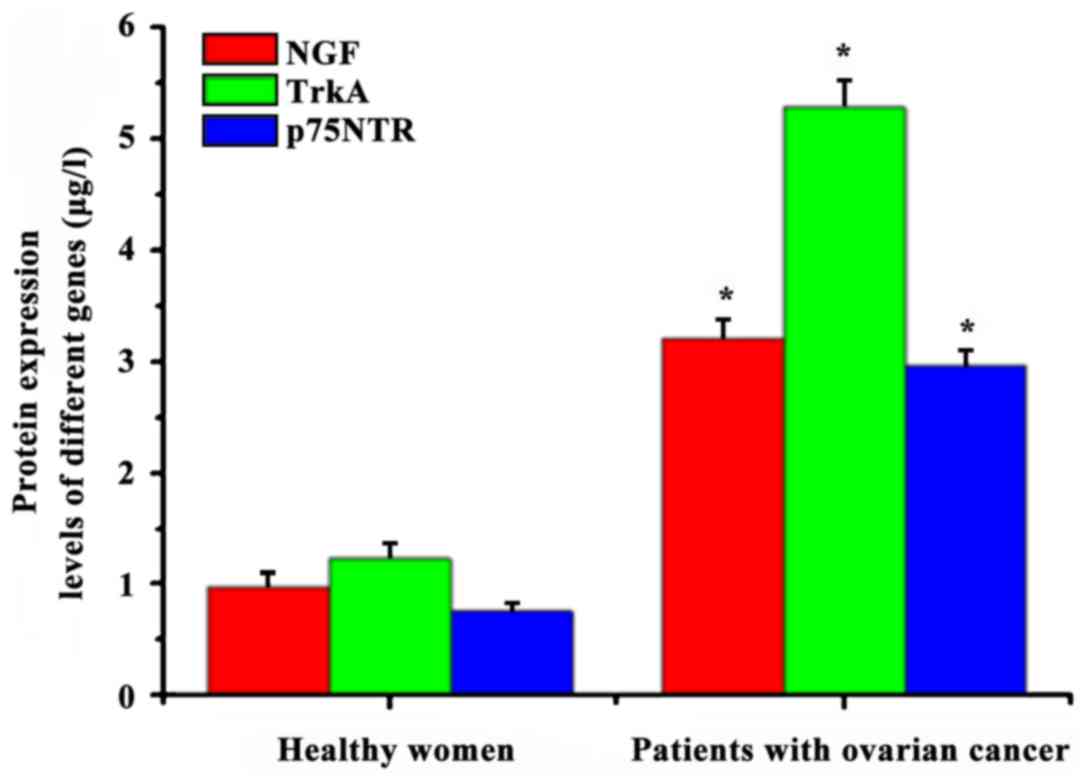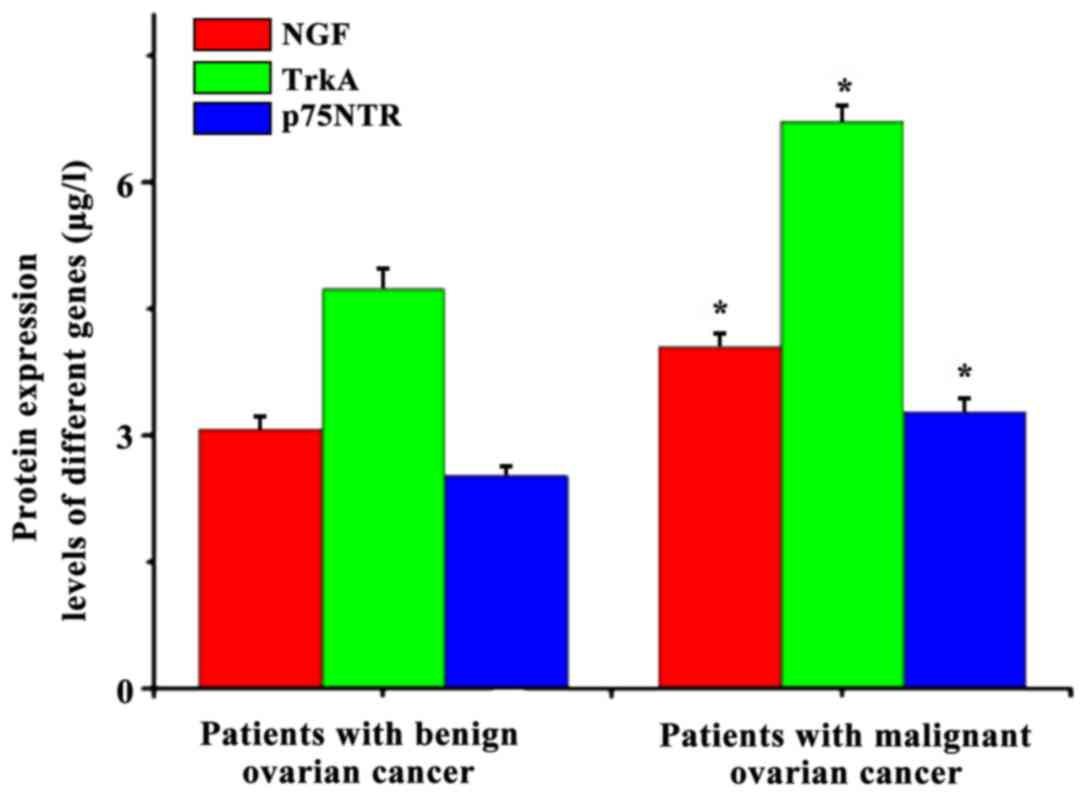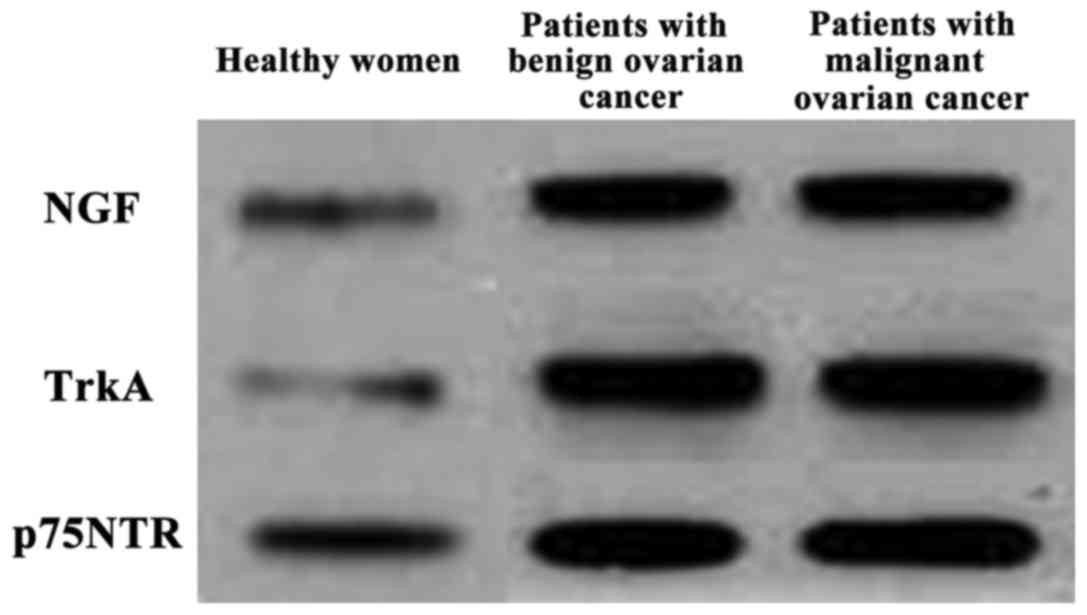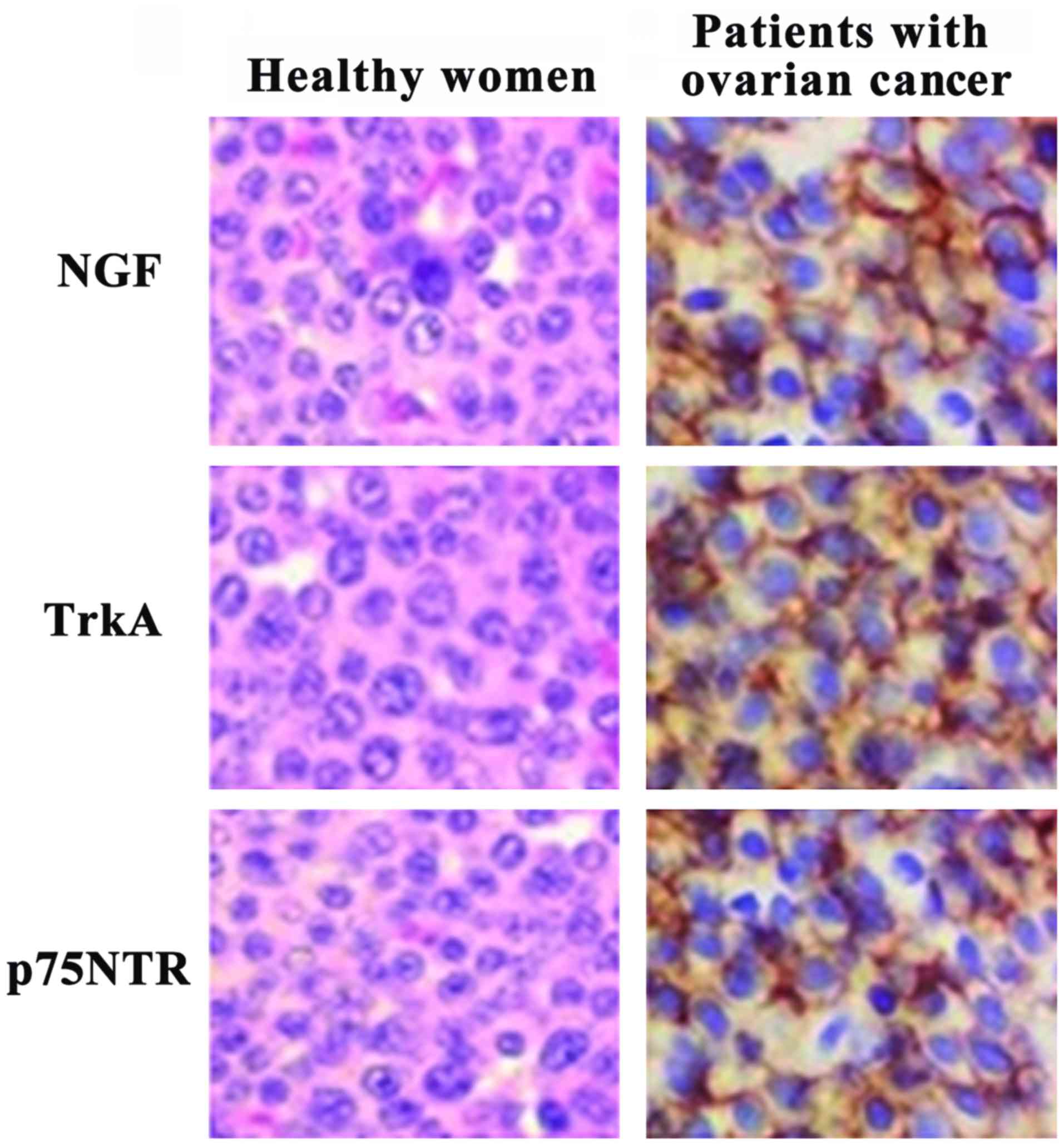Nerve growth factor and its receptors on onset and diagnosis of ovarian cancer
- Authors:
- Published online on: July 6, 2017 https://doi.org/10.3892/ol.2017.6527
- Pages: 2864-2868
-
Copyright: © Yu et al. This is an open access article distributed under the terms of Creative Commons Attribution License.
Abstract
Introduction
As one of the three common major malignant gynecological tumors, ovarian cancer does greater harm to women's health than cervical cancer and endometrial cancer (1) due to the difficult early diagnosis and low diagnosis rate. Clinical statistics show that (2) the pathogenic site of ovarian cancer is mainly located deep in the pelvis. So it is hard to detect the site of the lesion. Moreover, ovarian cancer has no significant clinical symptoms, and the lack of effective detection greatly contributed to the mortality associated with ovarian cancer in China that has an increasing trend in recent years (3) albeit the 5-year survival rate is maintained between 20 and 30% (2). So, the study on pathogenesis of ovarian cancer has become an important direction for treatment and diagnosis of ovarian cancer. In the 1950s, the nerve growth factor (NGF) was found for the first time, and its important role (4) not only in the nerve cell proliferation and function, but also in non-nerve cells was established. Study results showed that (5) the level of expression of NGF and its receptor had significant correlation with the proliferation, differentiation and migration of tumor cells in esophageal cancer and colon cancer (6). The detection of NGF in lesion tissue of colon cancer and normal colon tissue show that the quantity of expression of NGF and its receptor in colon cancer tissue is 57.3 times of that in normal colon tissue. Although NGF and its receptors cannot be used as the marker of malignant tumor (7), its abnormal expression in malignant tumor can significantly promote the abnormal proliferation of malignant tumor and cancer cells. Besides, it was reported that (8) NGF and its receptors can promote the spread of malignant melanoma, acute leukemia and pancreatic cancer cells in the body through blood circulation, in both paracrine and autocrine manner. But there is little study at present on the NGF and its receptors, onset and diagnosis of ovarian cancer. Herein, we studied the effect of NGF and its receptors on the onset and diagnosis of ovarian cancer for the first time to provide certain theoretical and experimental basis for the early diagnosis and treatment of ovarian cancer.
Patients and methods
Patient information
The study was conducted on 35 patients with ovarian tumor admitted in the First Affiliated Hospital of Nanchang University from July 2014 to July 2015. They were selected as the observation group (21 patients with benign ovarian tumor, with average age of 47.4±5.4 years and 14 patients with malignant ovarian tumor with an average age of 43.6±6.2 years) and 21 healthy women, selected as control group (their average age was 45.2±3.8 years). This study was approved by the Ethics Committee of the First Affiliated Hospital of Nanchang University. Signed written informed consents were obtained from all the participants before the study.
Main reagents
RNA extraction kit (Takara Bio, Dalian, China), total zooblast protein extraction kit (Axygen, Beijing, China), Rabbitpolyclonal NGF antibody (dilution, 1:500; cat. no. ab6199), rabbit monoclonal TrkA antibody (dilution, 1:500; cat. no. ab76291), rabbit polyclonal p75NTR antibody (dilution, 1:500; cat. no. ab8874) and secondary goat anti-rabbit (HRP) IgG antibody (dilution, 1:2,000; cat. no. ab6721) were all purchased from Abcam (Cambridge, MA, USA), immunohistochemical kit (Axygen).
Main instruments
Fluorescent microscope (ABM China Co., Ltd.), protein electrophoresis apparatus (Liuyi, Beijing, China), fluorescent microscope (Olympus Corp., Tokyo, Japan), multifunctional microplate reader (Bio-Rad, Berkeley, CA, USA).
Methods
Fluorescent quantitative PCR RNA extractionIn the experimental process, RNA in tissue samples of different study subjects was extracted using Takara RNA extraction kit. Tissue sample (0.5 g) was taken accurately and lysis buffer was added using a pipette. The RNA Plus was added for cell lysis, and centrifuged for 10 min at 800 × g at 4°C. The supernatant was added into the isometric chloroform, and the liquid was violently shaken, mixed and centrifuged for 5 min at 800 × g. The supernatant was then added into the isometric isoamyl alcohol, placed at room temperature for 5 min, and centrifuged for 15 min at 800 × g at 4°C. The supernatant was abandoned, washed using 75% absolute ethyl alcohol twice, placed at room temperature for 20 min. De-RNA enzyme sterile water was added after ethyl alcohol was volatilized; RNA concentration was detected and RNA integrity was verified (9).
Fluorescent quantitationThe total RNA extracted was used as the template, reversed to obtain cDNA, and then fluorescent quantitation was carried out in accordance with the specifications. The total volume was 10 µl. Primers are shown in Table I.
ELISAThe total protein extracted in the experiment was used as in study, and the total protein content in different samples was detected through Coomassie brilliant blue staining. There was 2.5 µg total protein in the process of ELISA (Keygen, Nanjing, China). Sample (100 µl) was placed into a 96-well plate, 35 µl detection liquid A was added, and incubated for 1 h at room temperature; detection liquid B was added, and incubated for 30 min at 37°C. The stop solution was added finally, and 475 nm absorbance was detected (10).
Western blottingWe used the zooblast protein extraction kit (Axygen) to extract the total protein in the sample (the concrete operation should be in accordance with the specification), and with improvements (11). Different study samples (0.5 mg) were taken accurately; after the total protein was extracted, the quantification was performed through Coomassie brilliant blue staining. The primary antibody in the experiment was used diluted 1:1,000.
ImmunohistochemistryThe regular antibody incubation and staining for tissue samples in nerve cells and its receptor were conducted through the streptavidin peroxidase method. The standard immunohistochemical evaluation was as follows: The sample with membrane staining <10% or that was negative after staining was considered as negative (12); the sample with only membrane staining or membrane staining >10% was considered as positive.
Data processingThe results were analyzed, and the data are presented as mean ± standard deviation; SPSS 10.0 (SPSS, Inc., Chicago, IL, USA) was used for analysis; P<0.05 was considered to indicate a statistically significant difference.
Results
Expression quantity of mRNA in nerve cells and its receptor in the patients with ovarian cancer and healthy people
The total RNA extracted from different study samples was assessed (Fig. 1A). Electrophoretogram showed that the RNA extracted was of good quality and no significant degradation was observed. Fluorescent quantitative PCR was used to detect the difference of expression quantity of NGF and its receptor in different samples, and the results are shown in Fig. 1, indicating that compared with healthy women, the expression quantity of mRNA in NGF, TrkA and p75NTR gene in patients with ovarian cancer was significantly increased, and there was significant difference in the quantity of expression of mRNA in NGF, TrkA and p75NTR gene and healthy ovary (P<0.05).
Quantity of expression of mRNA in nerve cells and its receptor in patients with benign ovarian tumor and patients with malignant ovarian tumor
RNA extracted from the lesion tissue sample of patients with ovarian cancer in the observation group was studied. The difference in quantity of expression of mRNA in nerve cells and its receptor in patients with benign ovarian tumor and patients with malignant ovarian cancer was detected (Fig. 2). The quantity of expression of mRNA in GF, TrkA and p75NTR gene in patients with benign ovarian cancer was significantly lower than that in patients with malignant ovarian cancer. This suggested correlation between the quantity of expression of mRNA in GF, TrkA and p75NTR gene and the severity of ovarian cancer.
Protein expression quantity of nerve cells and its receptor in the patients with ovarian cancer and healthy women
The quantity of protein expression in NGF and its receptor in different samples was detected using ELISA, and the results are shown in Fig. 3. The quantity of expression of NGF in healthy women (0.98±0.12 µg/l) was significantly lower than that in lesion tissue in patients with ovarian cancer (3.21±0.16 µg/l), and there were significant differences between them (P<0.05). The quantity of expression of NGF receptor, TrkA and p75NTR, in healthy women (1.23±0.14 and 0.76±0.07 µg/l, respectively) was significantly lower than that in lesion tissue in patients with ovarian cancer (5.28±0.25 and 2.97±0.13 µg/l, respectively), and there were significant differences (P<0.05).
The result was consistent with that of fluorescent quantitative PCR. This shows that the content of NGF, TrkA and p75NTR genes is different in healthy women and patients with ovarian cancer, which may be associated with ovarian cancer.
The quantity of protein expression of nerve cells and its receptors in women with benign ovarian tumor and patients with malignant ovarian tumor
The protein extracted from the lesion tissue samples of patients with ovarian cancer in observation group was used, and the difference of protein expression quantity of NGF and its receptor in the patients with benign ovarian tumor and patients with malignant ovarian tumor was detected, and the results are shown in Fig. 4. The quantity of protein expression of GF, TrkA and p75NTR gene in patients with benign ovarian tumor (3.08±0.14, 4.73±0.25 and 2.53±0.11 µg/l, respectively) was significantly lower than that in patients with malignant ovarian tumor (4.06±0.16, 6.73±0.18 and 3.29±0.15 µg/l, respectively). This suggests that there is a certain correlation between the quantity of protein expression of GF, TrkA and p75NTR gene and the severity of ovarian cancer.
Detection of protein expression quantity of nerve cells and its receptor in different samples using western blot analysis
The total protein extracted from the healthy women, patients with benign ovarian tumor and patients with malignant ovarian tumor was assessed, and the difference of protein expression quantity of nerve cells and its receptor in the samples was detected using western blot analysis, and the results are shown in Fig. 5. The quantity of protein expression of NGF, TrkA and p75NTR gene in patients with benign ovarian tumor and patients with malignant ovarian tumor was increased significantly compared with that in healthy women; and there were significant differences, which was consistent with the results of ELISA. It suggests that there is a certain correlation between the NGF and its receptor and the onset of ovarian cancer.
Detection of the quantity of protein expression of nerve cells and its receptor in samples using immunohistochemistry
The distribution and expression of protein in NGF and its receptor in the samples (Fig. 6) were detected using immunohistochemical method. Compared with healthy ovarian tissue, the quantity of expression of NGF and its receptor in patients with ovarian cancer was higher, and mainly located on the cell membrane surface. The result of positive cell count showed that (Table II) the number of positive cells in NGF, TrkA and p75NTR in normal ovarian tissue (8.75, 6.5 and 4.5%) was significantly lower than that in lesion tissue in patients with ovarian cancer (91.25, 93.5 and 95.5%, respectively). The result was consistent with that of fluorescent quantitative PCR and ELISA, suggesting that the NGF and its receptors are related to the onset of ovarian cancer.
Discussion
The morbidity and mortality of ovarian cancer, as the main gynecological disease endangering women's health at present, has showed an increasing trend year by year in women in China. But the early diagnosis of ovarian cancer is difficult and there is no special drug treatment. So no significant improvement has been made in the treatment of patients with ovarian cancer in China in recent years. The study results show that (13) the onset of ovarian cancer is influenced not only by environmental factors, but also by genetic factors. For example, it is believed in most studies that the onset of ovarian cancer is related to many other factors, such as the body immune dysfunction, endocrine dyscrasia and diet. Studies have shown that (14) the NGF, as a kind of polypeptide hormone, mainly aims to promote the nerve cell proliferation and the transmission of substance and signal between nerve cells. The abnormal increase of quantity of expression of NGF in many tumors and cancers have been shown (15). For example, some studies have shown that (16) the expression quantity of NGF in colon cancer is 28 times of that in normal colon tissue. The statistical result of patients' rehabilitation states after colon cancer surgery shows that the NGF and its receptor can affect the peripheral tumor cell proliferation and migration process in autocrine and paracrine manner suggesting that the NGF and its receptor may be associated with the late recovery of the tumor. Data showed that (17) the NGF receptors mainly include TrkA and p75NTR, among which NGF can be combined with TrkA in the early stage of tumor, thus promoting the abnormal increase of expression quantity of TrkA in tumor cells. Data showed that TrkA is considered to be the proto-oncogene expression product in human body, and further studies found that (18) TrkA can be involved in the expression of vascular endothelial growth factor; thus promoting the formation of tumor vessels. With the deepening of the study on NGF and TrkA, it has been found that the NGF receptor p75NTR can interact with TrkA in some cancers, such as cervical cancer, promoting the tumor cell proliferation and migration process. Only by combining with p75NTR can TrkA play its function. But in endometrial carcinoma, the individual TrkA can also play the role of NGF receptor. Therefore, no final conclusion has yet been reached on the relationship between NGF and its receptors (19). In our study, it was found that mRNA and protein content in NGF, TrkA and p75NTR genes in ovarian cancer tissue were significantly increased compared with those in normal ovarian tissue, and there were also differences in the expression quantity of NGF, TrkA and p75NTR between the benign ovarian tumor and malignant ovarian tumor. This suggests that NGF, TrkA and p75NTR play important roles in the progression of ovarian cancer, so they can act as the markers and diagnostic criteria of detecting ovarian cancer to some extent.
Acknowledgements
This study was supported by the Natural Science Foundation of Jiangxi Province (project no. 20132BAB205107).
References
|
Li L, Ji J, Wang JB, Niyazi M, Qiao YL and Boffetta P: Attributable causes of breast cancer and ovarian cancer in China: Reproductive factors, oral contraceptives and hormone replacement therapy. Chin J Cancer Res. 24:9–17. 2012. View Article : Google Scholar : PubMed/NCBI | |
|
Gao J, Gao G, Zhang Y and Wang F: Proteomic analysis of human epithelial ovarian cancer xenografts in immunodeficient mice exposed to chronic psychological stress. Sci China Life Sci. 54:112–120. 2011. View Article : Google Scholar : PubMed/NCBI | |
|
Itamochi H: Targeted therapies in epithelial ovarian cancer: Molecular mechanisms of action. World J Biol Chem. 1:209–220. 2010. View Article : Google Scholar : PubMed/NCBI | |
|
Bilici A, Ustaalioglu BB, Seker M, Canpolat N, Tekinsoy B, Salepci T and Gumus M: Clinical value of FDG PET/CT in the diagnosis of suspected recurrent ovarian cancer: Is there an impact of FDG PET/CT on patient management? Eur J Nucl Med Mol Imaging. 37:1259–1269. 2010. View Article : Google Scholar : PubMed/NCBI | |
|
Theveneau E, Marchant L, Kuriyama S, Gull M, Moepps B, Parsons M and Mayor R: Collective chemotaxis requires contact-dependent cell polarity. Dev Cell. 19:39–53. 2010. View Article : Google Scholar : PubMed/NCBI | |
|
Emoto S, Ishigami H, Yamashita H, Yamaguchi H, Kaisaki S and Kitayama J: Clinical significance of CA125 and CA72-4 in gastric cancer with peritoneal dissemination. Gastric Cancer. 15:154–161. 2012. View Article : Google Scholar : PubMed/NCBI | |
|
Wang Y, Xu RC, Zhang XL, Niu XL, Qu Y, Li LZ and Meng XY: Interleukin-8 secretion by ovarian cancer cells increases anchorage-independent growth, proliferation, angiogenic potential, adhesion and invasion. Cytokine. 59:145–155. 2012. View Article : Google Scholar : PubMed/NCBI | |
|
Barton DL, Burger K, Novotny PJ, Fitch TR, Kohli S, Soori G, Wilwerding MB, Sloan JA, Kottschade LA, Rowland KM Jr, et al: The use of Ginkgo biloba for the prevention of chemotherapy-related cognitive dysfunction in women receiving adjuvant treatment for breast cancer, N00C9. Support Care Cancer. 21:1185–1192. 2013. View Article : Google Scholar : PubMed/NCBI | |
|
Guerrero AT, Zarpelon AC, Vieira SM, Pinto LG, Ferreira SH, Cunha FQ, Verri WA Jr and Cunha TM: The role of PAF/PAFR signaling in zymosan-induced articular inflammatory hyperalgesia. Naunyn Schmiedebergs Arch Pharmacol. 386:51–59. 2013. View Article : Google Scholar : PubMed/NCBI | |
|
Liu C, Liu H, Wang X and Xinbo S: Clinical significance and expression of PAF and TNF-alpha in seminal plasma of leukocytospermic patients. Mediators Inflamm. 2012:6397352012. View Article : Google Scholar : PubMed/NCBI | |
|
Rota M, Pasquali E, Scotti L, Pelucchi C, Tramacere I, Islami F, Negri E, Boffetta P, Bellocco R, Corrao G, et al: Alcohol drinking and epithelial ovarian cancer risk. a systematic review and meta-analysis. Gynecol Oncol. 125:758–763. 2012. View Article : Google Scholar : PubMed/NCBI | |
|
Kim HA, Kim KJ, Seo KH, Lee HK and Im SY: PTEN/MAPK pathways play a key role in platelet-activating factor-induced experimental pulmonary tumor metastasis. FEBS Lett. 586:4296–4302. 2012. View Article : Google Scholar : PubMed/NCBI | |
|
Arai Y, Totoki Y, Hosoda F, Shirota T, Hama N, Nakamura H, Ojima H, Furuta K, Shimada K, Okusaka T, et al: Fibroblast growth factor receptor 2 tyrosine kinase fusions define a unique molecular subtype of cholangiocarcinoma. Hepatology. 59:1427–1434. 2014. View Article : Google Scholar : PubMed/NCBI | |
|
Bilici A, Seker M, Ustaalioglu BB, Kefeli U, Yildirim E, Yavuzer D, Aydin FM, Salepci T, Oncel M and Gumus M: Prognostic significance of perineural invasion in patients with gastric cancer who underwent curative resection. Ann Surg Oncol. 17:2037–2044. 2010. View Article : Google Scholar : PubMed/NCBI | |
|
Kemp SW, Webb AA, Dhaliwal S, Syed S, Walsh SK and Midha R: Dose and duration of nerve growth factor (NGF) administration determine the extent of behavioral recovery following peripheral nerve injury in the rat. Exp Neurol. 229:460–470. 2011. View Article : Google Scholar : PubMed/NCBI | |
|
Rogers ML, Bailey S, Matusica D, Nicholson I, Muyderman H, Pagadala PC, Neet KE, Zola H, Macardle P and Rush RA: ProNGF mediates death of Natural Killer cells through activation of the p75NTR-sortilin complex. J Neuroimmunol. 226:93–103. 2010. View Article : Google Scholar : PubMed/NCBI | |
|
Teng KK, Felice S, Kim T and Hempstead BL: Understanding proneurotrophin actions: Recent advances and challenges. Dev Neurobiol. 70:350–359. 2010.PubMed/NCBI | |
|
Li C, Ma H, Wang Y, Cao Z, Graves-Deal R, Powell AE, Starchenko A, Ayers GD, Washington MK, Kamath V, et al: Excess PLAC8 promotes an unconventional ERK2-dependent EMT in colon cancer. J Clin Invest. 124:2172–2187. 2014. View Article : Google Scholar : PubMed/NCBI | |
|
Zhu Y, Li Y, Haraguchi S, Yu M, Ohira M, Ozaki T, Nakagawa A, Ushijima T, Isogai E, Koseki H, et al: Dependence receptor UNC5D mediates nerve growth factor depletion-induced neuroblastoma regression. J Clin Invest. 123:2935–2947. 2013. View Article : Google Scholar : PubMed/NCBI |



